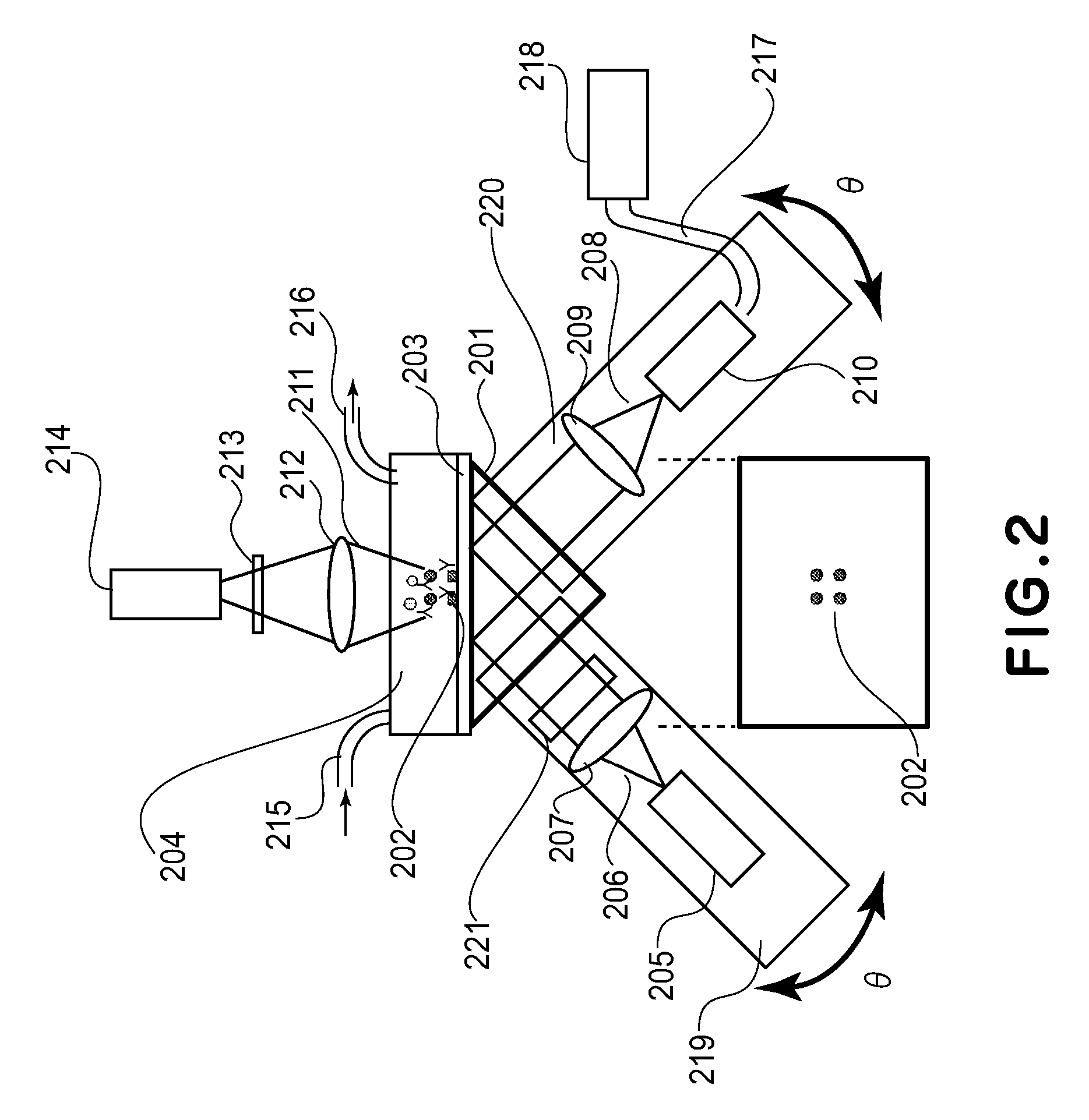Detection Apparatus and Detection Method for Plasmon Resonance and Fluorescence
a detection apparatus and fluorescence technology, applied in the field of detection apparatus and detection method of plasmon resonance and fluorescence, can solve the problems of difficult to measure the response speed with high sensitivity or a concentration of low-molecular weight compounds, and the inability to specify which site is cancerous
- Summary
- Abstract
- Description
- Claims
- Application Information
AI Technical Summary
Benefits of technology
Problems solved by technology
Method used
Image
Examples
embodiment 1
[0076] Referring to FIG. 2, onto a plane A of a prism 201 (“BK7”; A=28.3 mm, B=C=20 mm), an index matching fluid (“F-IMF-105”, mfd. by Newport Corp.) having the same refractive index as the prism 201 was applied and a substrate 203 on which a metal array 202 comprising a plurality of dots (metal films) each having a diameter of 100 μm was formed was caused to hermetically contact the prism 201.
[0077] To the substrate 203, a transparent reaction cell 204 in which a specimen and a washing liquid were introduced was bonded. As a light source 205, a laser diode (“DL3038-033”, mfd. by SANYO Electric Co., Ltd.) was used. As a collimating lens 207, a planoconvex lens (mfd. by SIGMA KOKI Co., Ltd.; diameter 5 mm) was used. As a filter 221, a polarizing filter (“SPF-30C-32”, mfd. by SIGMA KOKI Co., Ltd.) was used.
[0078] This incident optical system was fixed on an arm 219. As an optical sensor 210, a CCD area image sensor (“S7030-0906”, mfd. by Hamamatsu Photonics K.K.) was used. As a coll...
embodiment 2
[0098] Hybridization measurement of DNA was performed by using the optical system employed in Embodiment 1.
[0099] On the surface of each metal arrays, streptavidin was deposited, and 4 species of biotin-modified 20-mer DNA were adsorbed to prepare a nucleic acid sensor.
[0100] Detailed description will be made with reference to FIGS. 5(a) to 5(d).
[0101] As shown in FIG. 5(a) (plan view), on a 2×2 metal array 402 formed on a substrate 401, 4 species of biotin-modified 20-mer DNAs were fixed and subjected to the following protocol (procedure).
[0102] Fixation of different ligands on the metal array was performed according to a method described in U.S. Pat. No. 6,194,223.
[0103] (1) A specimen liquid in which four species (A*, B*, C* and D*) of composites 403, fluorescence-labeled with Cy5 dye, comprising DNA 405 (probe P) having fixed base sequence as shown in FIG. 5(b) and corresponding ligand DNAs (target T1, 20-mer as shown in FIG. 4(c) and four species of 20-mer DNAs (target T2;...
PUM
| Property | Measurement | Unit |
|---|---|---|
| Angle | aaaaa | aaaaa |
| Fluorescence | aaaaa | aaaaa |
| Resonance | aaaaa | aaaaa |
Abstract
Description
Claims
Application Information
 Login to View More
Login to View More - R&D
- Intellectual Property
- Life Sciences
- Materials
- Tech Scout
- Unparalleled Data Quality
- Higher Quality Content
- 60% Fewer Hallucinations
Browse by: Latest US Patents, China's latest patents, Technical Efficacy Thesaurus, Application Domain, Technology Topic, Popular Technical Reports.
© 2025 PatSnap. All rights reserved.Legal|Privacy policy|Modern Slavery Act Transparency Statement|Sitemap|About US| Contact US: help@patsnap.com



